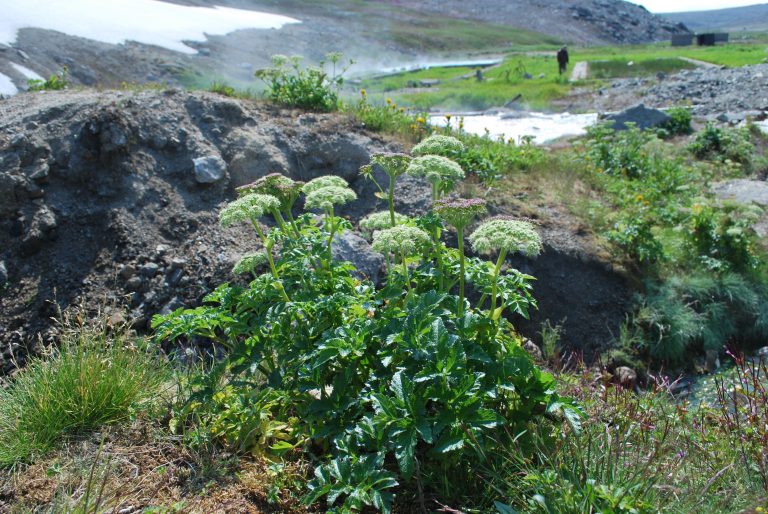Chukchi: икиту (ikiituk)
Naukan: икӣтук (ikiituk)
Central Alaskan Yup’ik: ikiituk
Russian: зонтик (zontik), дудник (dudnik)
English: wild celery (common name used in Alaska)
Naukan:
Angelica gmelinii is one of the most important medicinal and spiritual plants to the Naukan people. It only grows in warm places. The root is gathered whole for spiritual purification. People dry them and store them at home. It is burned, and the smoking root is carried around to different rooms of the house and in doorway, to purify them. This can be done after someone has died or after a quarrel, or to rid the house of general bad spiritual influences. The smoke can also be used on individual people, when a hunter has had bad luck, or after someone had a bad dream. Fumigating a house with the smoke also serves to purify the air and prevent illness in general, and can be used on a specific person who is sick, for example, with asthma. People in Uelen also eat a small piece of the dried root after the first whale of the year is killed.
Дудник Angelica gmelinii – одно из самых важных медицинских и магических растений науканцев. Растет он только в теплых местах. Корень выкапывают целиком для духовного очищения. Корни сушат и хранят в доме. Подожженный и дымящийся корень проносят по комнатам жилища и через порог, чтобы очистить их. Это делают в случае смерти, после ссоры или чтобы избавить дом от влияния злых духов. Дым также используют для очищения отдельного человека, если охотника постигла неудача или после того, как кому-то приснился плохой сон. Окуривание дома также служит для очищения воздуха и для предотвращения болезней. Дым может быть использован для лечения некоторых больных, например, тех, кто страдает астмой. Уэленцы съедают маленький кусочек засушенного корня после того, как убит первый кит в году.
Chukchi:
Coastal Chukchi people in the Chukotskiy district have similar uses for the root of this species as Naukan people. They likely borrowed these practices from the Naukan. Elders said that the root should be dug up whole and an offering of food or other small object should be made. It is then dried to store. The root is burned and carried around the house for spiritual purification. This can be done against bad spirits, after someone has died, or so nothing bad will happen in the future. An individual person can also be purified this way, including when someone is feeling bad emotionally. People also inhale smoke from the root to treat colds and illness in general.
Береговые чукчи Чукотского района используют корни этого растения схожим образом с науканскими эскимосами, у которых они, вероятно, и заимствовали эту традицию. Старики говорят, что корень нужно выкопать целиком и оставить взамен немного еды или небольшой предмет. Затем корень высушивают и хранят. Его поджигают и обносят вокруг дома с целью ритуального очищения. Это может быть защита от злых духов, окуривание после чьей-либо смерти или предотвращение чего-либо плохого в будущем. Таким же образом можно очистить и отдельного человека, например, когда у него подавленное эмоциональное состояние. Также дым от тлеющего корня вдыхают, чтобы вылечить простуду и в целом улучшить здоровье.
Central Alaskan Yup’ik:
The stem of the young Angelica lucida can be peeled and eaten raw. Plants that are flowering and older ones with tough stems should not be eaten. The root can be dried and crushed to use on bruises or burns. It can also be massaged in the skin for bodily aches and pains. Eating the stem is said to be good for treating tapeworms. For more details see the following publication by Dr. Jernigan and collaborators.



